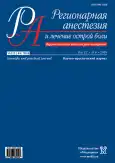Comparative evaluation of regional blockades during arthroscopic shoulder surgery
- Authors: Trukhin K.S.1, Zabolotskii D.V.2, Koriachkin V.A.2, Kuleshov O.V.1, Cherednichenko A.A.1, Kulikov A.Y.1, Zakharov K.I.1
-
Affiliations:
- Clinic of High Medical Technologies named N. I. Pirogov, St. Petersburg State University
- Saint-Petersburg State Pediatric Medical University of the Ministry of Healthcare of the Russian Federation
- Issue: Vol 12, No 4 (2018)
- Pages: 242-249
- Section: Original articles
- URL: https://bakhtiniada.ru/1993-6508/article/view/61296
- DOI: https://doi.org/10.17816/1993-6508-2018-12-4-242-249
- ID: 61296
Cite item
Full Text
Abstract
Objective: To evaluate the effectiveness of interscalene brachial plexus block versus combined suprascapular and axillary nerves block for shoulder arthroscopy. Methods: In this prospective study 174 patients were operated on the shoulder joint by the arthroscopic method under combined anesthesia. In the 1st group (n=96), for the purpose of analgesia, patients got interscalene brachial plexus block; in the 2nd group (n=78), patients received suprascapular and axillary nerves block. Ultrasound visualization and neurostimulation were used in both groups. Recorded the time from the start of blockade to the start of the operation, as well as the duration of the sensory and motor blockade. The intensity of postoperative pain was assessed with a 10-point Numeric rating scale, the need for additional analgesia, the quality of night sleep, and patient comfort. Neurological complications were also recorded.
Results: There were no differences in the time from the admit patients to the operating room and before the start surgery. The analgesic effect in the early postoperative period in the 1st group was higher, but by the end of the first day there was no statistical difference between the groups in the intensity of the pain syndrome. Intake of non-narcotic and narcotic analgesics was higher in the 2nd group. Complications were noted only for the 1st group: diaphragm paresis in 6 (6.25%) patients, in 2 (2.08%) – recurrent laryngeal nerve blockade. Satisfaction with postoperative analgesia was 100% in patients of the 2nd group. The choice of regional anesthesia for arthroscopic interventions on the shoulder did not affect the length of hospitalization.
Conclusion: Selective anesthesia of the suprascapular and axillary nerves during shoulder arthroscopic surgery is an alternative of interscalene brachial plexus block; it is not associated by respiratory and neurological complications; does not violate movements in the distal upper limb, reduces psychological discomfort and anxiety of patients.
Full Text
##article.viewOnOriginalSite##About the authors
K. S. Trukhin
Clinic of High Medical Technologies named N. I. Pirogov, St. Petersburg State University
Email: zdv4330303@gmail.com
Russian Federation, St. Petersburg
Dmitry V. Zabolotskii
Saint-Petersburg State Pediatric Medical University of the Ministry of Healthcare of the Russian Federation
Author for correspondence.
Email: zdv4330303@gmail.com
MD, PhD, DSc, assistent-professor, Department of Anesthesiology, Reanimatology and Emergency Pediatric
Russian Federation, St. PetersburgV. A. Koriachkin
Saint-Petersburg State Pediatric Medical University of the Ministry of Healthcare of the Russian Federation
Email: zdv4330303@gmail.com
Russian Federation, St. Petersburg
O. V. Kuleshov
Clinic of High Medical Technologies named N. I. Pirogov, St. Petersburg State University
Email: zdv4330303@gmail.com
Russian Federation, St. Petersburg
A. A. Cherednichenko
Clinic of High Medical Technologies named N. I. Pirogov, St. Petersburg State University
Email: zdv4330303@gmail.com
Russian Federation, St. Petersburg
A. Yu. Kulikov
Clinic of High Medical Technologies named N. I. Pirogov, St. Petersburg State University
Email: zdv4330303@gmail.com
Russian Federation, St. Petersburg
K. I. Zakharov
Clinic of High Medical Technologies named N. I. Pirogov, St. Petersburg State University
Email: zdv4330303@gmail.com
Russian Federation, St. Petersburg
References
- Memtsoudis S.G., Kuo C., Ma Y., Edwards A., Mazumdar M., Liguori G. Changes in anesthesia-related factors in ambulatory knee and shoulder surgery: United States 1996-2006. Regional Anesthesia and Pain Medicine. 2011; 36 (4): 327–31.
- Zabolotskiy D.V., Koryachkin V.A. Rebenok i regionarnaya anesteziya – zachem? kuda? i kak? Regionarnaya anesteziya i lecheniye ostroy boli. 2016; 10(4): 243–53. (In Russian)
- Kessler J., Marhofer P., Hopkins P.M., Hollmann, M.W. Peripheral regional anaesthesia and outcome: Lessons learned from the last 10 years. Br. J. Anaesth. 2015; 114 (5): 728–45.
- Patent № 2645639 Rossiyskoy Federatsii, MPK A61M 19/00 (2006.01), A61B 8/00 (2006.01). [Tekst] / Trukhin K., S., Koryachkin V.A., Kuleshov O.V., Zabolotskiy D.V, Cherednichenko A.A., Zakharov K.I. , Dubovik V.V .; zayavitel’ i patentoobladatel’ Federal’noye gosudarstvennoye byudzhetnoye uchrezhdeniye «Sankt-Peterburgskiy mnogoprofil’nyy tsentr» Ministerstva zdravookhraneniya Rossiyskoy Federatsii (RU) – № 2016115499, zayavl. 21.04.2016; opubl. 21.02.2018-27.02.2018 Byul. No 6.
- Auyong D., Hanson N., Joseph R., Schmidt B., Slee, A., Yuan S. Comparison of anterior suprascapular, supraclavicular, and interscalene nerve block approaches for major outpatient arthroscopic shoulder surgery. Anesthesiology. 2018; 129 (1): 47–57.
- Dhir S., Sondekoppam R.V., Sharma R., Ganapathy S., Athwal G.S. A comparison of combined suprascapular and axillary nerve blocks to interscalene nerve block for analgesia in arthroscopic shoulder surgery an equivalence study. Regional Anesthesia and Pain Medicine. 2016; 41 (5): 564–71.
- Tran D.Q.H., Elgueta M. F., Aliste J., Finlayson R.J. Diaphragm-sparing nerve blocks for shoulder surgery. Regional Anesthesia and Pain Medicine. 2017; 42 (1): 32–8.
- Renes S.H., Spoormans H.H., Gielen M.J., Rettig H.C., Van Geffen G.J. Hemidiaphragmatic paresis can be avoided in ultrasound-guided supraclavicular brachial plexus block. Regional Anesthesia and Pain Medicine. 2009; 34 (6): 595–9.
- Riazi S., Carmichael N., Awad I., Holtby R.M., McCartney C.J.L. Effect of local anaesthetic volume (20 vs 5 ml) on the efficacy and respiratory consequences of ultrasound-guided interscalene brachial plexus block. British. Journal of Anaesthesia. 2008, 101 (4); 549–56.
- Dhir S., Sondekoppam R.V., Sharma R., Ganapathy S., Athwal G.S. (). A comparison of combined suprascapular and axillary nerve blocks to interscalene nerve block for analgesia in arthroscopic shoulder surgery an equivalence study. Regional Anesthesia and Pain Medicine. 2016; 41 (5): 564–571.
- Nam Y.S., Panchal K., Kim I.B., Ji J.H., Park M.G., Park S.R. Anatomical study of the articular branch of the lateral pectoral nerve to the shoulder joint. Knee Surgery, Sports Traumatology, Arthroscopy. 2016; 24 (12): 3820–7.
- Hussain, N., Goldar, G., Ragina, N., Banfield, L., Laffey, J. G., Abdallah, F. W. Suprascapular and Interscalene Nerve Block for Shoulder Surgery: A Systematic Review and Meta-analysis. Anesthesiology. 2017; 127 (6): 998–1013
Supplementary files















